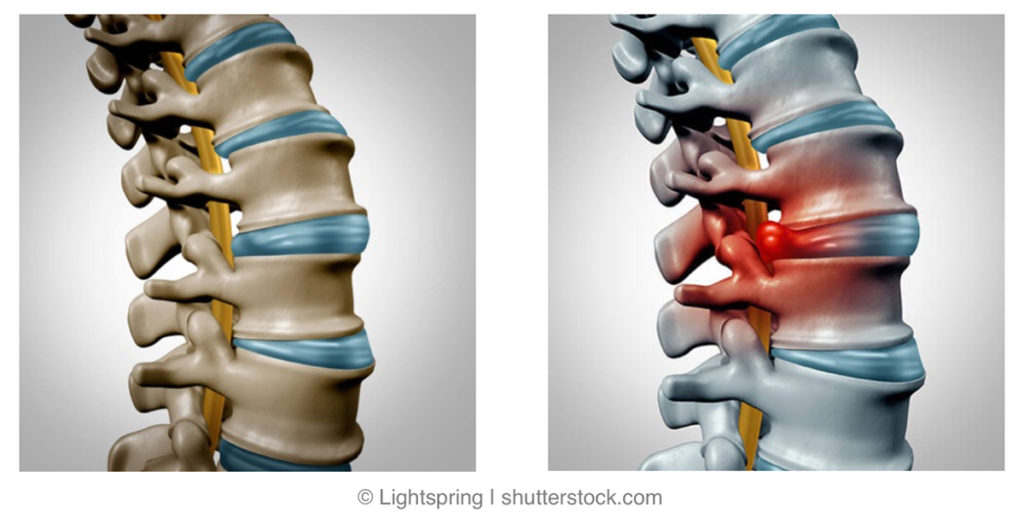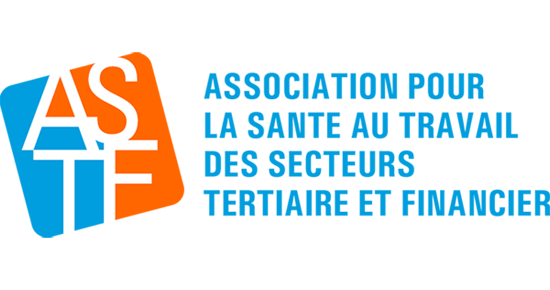Back pain is one of the most important causes of incapacity for work. One in three adults suffers from back pain more often or permanently.
Anatomy
The human spine has two different functions. On the one hand it holds the body upright and carries the load of head, torso and arms. On the other hand, it also serves as protection for the spinal cord running in the spinal canal.
The spine itself is composed of various individual elements: Firm bone – 24 vertebrae: 7 cervical, 12 thoracic, 5 lumbar (33 in total including sacrococcygeal vertebrae: 5 fused vertebrae of the sacrum and 3 to 5 fused vertebrae of the coccyx), relatively soft cartilage (23 intervertebral discs) and numerous ligaments . The latter guarantee a firm cohesion and also the mobility of the individual vertebrae among each other. Seen from the front, a healthy spinal column is absolutely straight. Seen from the side, the vertebrae and intervertebral discs form a double S-shape, which gives the spine its typical design. Due to this special curved shape, the spine can reduce vibrations and distribute them evenly over its entire length.

Reasons for back pain
Back pain has many possible causes and is usually self-limiting and not dangerous. The most common causes are musculoskeletal and are non-specific. Any of the anatomical structures described above can cause pain.
Each so-called non-specific low back pain is based on a particular issue, e.g. the irritation of a small vertebral joint or the painful blocking of a vertebral segment. Approximately 90% of patients with this diagnosis are usually symptom-free after four weeks at the latest without any special treatment. However, pain can also occur in the cervical and thoracic areas of the spine.
Given the frequency of back pain and the ratio of specific to non-specific back pain (1: >4), not every back pain is associated with a more or less serious illness. Only in the case of atypical, persistent or increasing pain, or in certain risk constellations should it be considered a sign of illness (symptom).
Work-related musculoskeletal disorders (MSDs) are closely related to physical strain, and are primarily so-called degenerative diseases, i.e. signs of wear and tear. These include, for example:
- degenerative diseases of the cervical and lumbar spine;
- degenerative diseases of the joints, such as arthrosis of the wrists, elbows, knees and hip joints;
- specific and non-specific reactions of muscles and other structures to static or repeated continuous loading. These include diseases of tendons, ligaments, menisci and synovial bursa.
The outer ring of an intervertebral disc consists of several layers of actually tear-resistant fibres. This cartilaginous fibrous ring (Anulus fibrosus) stabilizes the intervertebral discs and attaches itself to the vertebral bodies. Inside is a soft gelatinous core (nucleus pulposus) which consists of 80 to 85 percent water. Thanks to its high water content, it ensures that the intervertebral disc cushions the pressure load between the vertebral bodies like a shock absorber.
The intervertebral disc tissue supplies itself with nutrients via the surrounding tissue fluid just like a sponge. It takes up nutrients during a cycle of compression and release : When pressure is exerted on the intervertebral disc, the fluid is pressed out of the gelatinous core. This reduces the water content of the nucleus. If the intervertebral disc is relieved, the nucleus is again filled with the liquid and nutrients.
If this cycle is not properly guaranteed, the intervertebral discs become friable and cracked: The risk of a herniated disc thus increases significantly. In a first step the intervertebral disc deforms (protrusion). If the fibrous ring can no longer withstand the pressure, it ruptures and literally bursts : A part of the gelatinous core emerges and presses itself into the spaces between the vertebral bodies. This outlet represents the prolapse, the herniated disc.

About two thirds of all herniated discs are located in the lumbar spine, 30% in the cervical spine and less frequently in thoracic spine region.
Among the most common symptoms are:
- back pain that occurs suddenly and increases with exertion/movement;
- sneezing and coughing typically increase pain in the lumbar or thoracic spine;
- hardened back muscles in the affected section of the spine;
- radiating pain to the buttocks or leg/arm and hand, neck pain, headaches;
- ingling in the leg/arm (“ants on the skin”, “needlesticks”, “current in the body »);
- deficits such as numbness, cold or weakness in the leg.
The pain is triggered not only by muscular and fascial traction but also by local pressure on the surrounding tissue, especially nerve tissue.
Attention pain trap!
If you do not effectively counteract your back pain immediately, you may get into a vicious cycle: This leads to increasing muscle imbalances and pain and the affected person is put into a relieve posture, which in turn leads to new tension and strain and thus even more pain. Grief, anxiety and depression increase back pain. One of the reasons for this is that pain always has an emotional side. If you also suffer from something else, the suffering aspect of pain is also increased. Stress leads to physical excitement and therefore, among other things, to increased muscle tension. If stress lasts longer, and with it muscle tension, pain can develop.
Benefit of physical activity and sport
Physical inactivity is not only linked to certain cardiovascular diseases, the development of coronary heart disease, high blood pressure, and may contribute to depression.
The more or less static posture during sitting with constant pressure on the intervertebral discs and the lack of activity and thus decreased blood circulation in our muscles can cause undue strain, tightness, pain and even injuries in the neighbouring joints, respectively discs.
Back, neck and shoulder pains, repetitive strain injury, headache, eyestrain present possible health issues common with incorrect use of PCs and laptops, poorly designed workstations or work environments.
With an individually adjusted workstation design and « mini breaks » these issues can be prevented.
However, these corrections do not replace sport or regular physical exercise, which significantly reduce the risk of back pain! Among other things sport can help you to avoid muscular imbalances, to strengthen your trunk musculature, to ensure a muscular stabilisation of the spine, to train body awareness and to improve stress sensitivity.
For chronic back pain, exercise and sport programmes can prevent recurrences and can help to reduce the duration and severity of back pain.
Conclusion
So get active, see how you can release your musculo-skeletal system and feel a refreshing effect. More information can be found in our “mini breaks” article.
Download this article as a pdf file and a poster to print for your premises.


